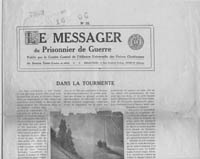Table of Contents
Appendix 8g
Le Messager du Prisonnier de Guerre
Der Gefangenenbote
(The Messenger to Prisoners of War)
 The World's Alliance of YMCA's in Geneva began publishing this newspaper for prisoners of war on a monthly basis beginning in July
1915 and continued the series until Christmas 1918 (the World's Alliance continued to distribute the newspaper to Central Power
prisoners of war in Allied captivity until March 1920). Ernst Sartorius was the first editor of the newspaper and served in this
position until March 1917 when he went to Bulgaria as the new Senior WPA Secretary in place of the scheduled American workers.
The World's Alliance appointed W. Gottsched as the new editor, under the direction of Dr. F. Louis Perrot. Originally printed in
English, French, and German, the editors expanded the publication into Russian and eventually Bulgarian, due to popular demand, by
the end of the war. The World's Alliance distributed the newspaper in prison camps in Britain, France, Germany, Austria-Hungary,
Russia, and Bulgaria and the subscription rate exceeded one million before the Armistice. To gain even greater exposure to inmates,
the Association encouraged prisoners to share the newspaper among their comrades after they had completed reading the issue. The
newspaper was printed in Lausanne, Switzerland by La Concorde.
The World's Alliance of YMCA's in Geneva began publishing this newspaper for prisoners of war on a monthly basis beginning in July
1915 and continued the series until Christmas 1918 (the World's Alliance continued to distribute the newspaper to Central Power
prisoners of war in Allied captivity until March 1920). Ernst Sartorius was the first editor of the newspaper and served in this
position until March 1917 when he went to Bulgaria as the new Senior WPA Secretary in place of the scheduled American workers.
The World's Alliance appointed W. Gottsched as the new editor, under the direction of Dr. F. Louis Perrot. Originally printed in
English, French, and German, the editors expanded the publication into Russian and eventually Bulgarian, due to popular demand, by
the end of the war. The World's Alliance distributed the newspaper in prison camps in Britain, France, Germany, Austria-Hungary,
Russia, and Bulgaria and the subscription rate exceeded one million before the Armistice. To gain even greater exposure to inmates,
the Association encouraged prisoners to share the newspaper among their comrades after they had completed reading the issue. The
newspaper was printed in Lausanne, Switzerland by La Concorde.
The contents of each edition was the same in terms of the material covered in the newspaper. By translating the same material, the YMCA was able to reduce costs and receive approval from Ministry of War censors in the belligerent countries. A major theme in the newspaper was religious and spiritual comfort for prisoners and special editions came out for Easter and Christmas. Each edition had an article on Bible verses to aid the POW in captivity and the editors included special hymns in some editions. Other topics included articles about mother and father, maternal love, and other reminders of loved ones at home. The Association also sought to improve the education of prisoners by covering scientific, historical, literary, and philsophical subjects which could be included in prison camp courses. The editors addressed scientific topics such as botany, biology, geology, and zoology. The April 1918 Le Messager du Prisonnier de Guerre focused on the banana. Historical articles examined the life of Abraham Lincoln and the proper pronunciation of "dead" classical languages. The work of Leon Tolstoi was a literary feature in the January 1918 edition, while art featuring animal forms appeared in the February 1918 publication. Exciting topics, such as the foundation of punctuation, was an article in June 1918. The editors encouraged prisoners to take advantage of educational opportunities offered by Red Triangle secretaries and used this newspaper to promote correspondence courses.
The YMCA Archives of the USA hold the French version of Le Messager du Prisonnier de Guerre for French and Belgian POWs in Central Power prisons and Der Gefangenenbote for German and Austrian prisoners in Allied camps (the French version is included in this appendix). The Association holdings begin with No. 25 (December 1917) through No. 31 (June 1918) and include the Christmas 1918 edition. Of note, while German and Austro-Hungarian authorities released French and Belgian POW's after the Armistice in November 1918, some French and Belgian prisoners remained in military hospitals in Germany due to serious illnesses and wounds which delayed their repatriation. The YMCA, which prepared the newspapers well ahead of time, still distributed the French editions to these unfortunates.1
Notes:
Note 1: Armed Services Records Box-139, Folder: "Le Messager du Prisonnier de Guerre," Kautz Family YMCA Archives, University of Minnesota, Minneapolis, MN. back